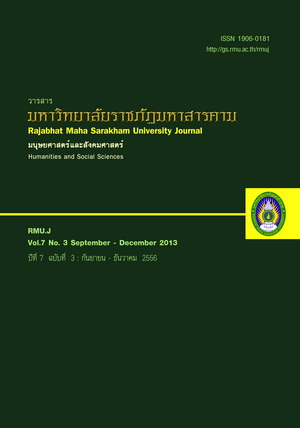A Conversational Implicature Analysis in J.K. Rowling’s Harry Potter and the Prisoner of Azkaban
Main Article Content
บทคัดย่อ
บทคัดย่อ
การวิจัยครั้งนี้มีวัตถุประสงค์เพื่อศึกษาและวิเคราะห์ความหมายนัยแฝงในบทสนทนาตามแนววัจนปฏิบัติศาสตร์ใน 30 บท สนทนาของตัวละครหลักทั้ง 7 ตัวในนวนิยายของ เจ.เค. โรว์ลิ่ง เรื่อง แฮร์รี่ พอตเตอร์กับนักโทษแห่งอัซคาบัน โดยใช้ทฤษฎีหลักการ ความร่วมมือของไกรซ์เพื่อศึกษาการละเมิดหลักการสนทนาของตัวละครหลัก นอกจากนี้การวิจัยครั้งนี้ยังอธิบายถึงวิธีที่ตัวละครหลัก ทั้ง 7 ตัวใช้เพื่อถ่ายทอดความหมายที่แท้จริงผ่านความหมายนัยแฝงในบทสนทนาและวิธีที่ตัวละครอีกฝ่ายในฐานะผู้ฟังตีความความ หมายที่ผู้พูดต้องการสื่อผ่านความหมายนัยแฝงได้
ผลการวิจัยพบว่ามีข้อความที่ให้ความหมายนัยแฝงจำนวนทั้งสิ้น 75 ข้อความ ตัวละครหลักทั้ง 7 ตัวได้กล่าวข้อความที่มี ความหมายนัยแฝงโดยมีสาเหตุมาจาก 19 สาเหตุด้วยกัน คือ เพื่อเสียดสี เพื่อประชดประชัน เพื่อยืนยันในข้อความที่พูด เพื่อการ คาดการณ์ เพื่ออธิบายความ เพื่อแสดงความไม่พึงพอใจ เพื่อแสดงความสุภาพ เพื่อโน้มน้าวผู้ฟัง เพื่อตอบคำถามทางอ้อม เพื่อแสดง ความไม่เห็นด้วยทางอ้อม เพื่อแสดงความคิดเห็นทางอ้อม เพื่อถามคำถามทางอ้อม เพื่อปฏิเสธทางอ้อม เพื่อเน้นความหมาย เพื่อหลีก เลี่ยงความลำบากใจ เพื่อการโกหก เพื่อเปลี่ยนหัวข้อในการสนทนา เพื่อหันเหความสนใจของผู้ฟังออกจากหัวข้อในการสนทนา และ เพื่อกีดกันบุคคลที่สามออกจากการสนทนา นอกจากนี้ยังพบว่า ในการสื่อความหมายที่แท้จริงผ่านความหมายนัยแฝงในบทสนทนา ของตัวละครในฐานะผู้พูดและการตีความความหมายที่แท้จริงของตัวละครในฐานะผู้ฟังนั้นขึ้นอยู่กับ ข้อความ บริบทของสถานการณ์ พื้นความรู้ของตัวละครแต่ละตัว และความรู้ในแง่หลักการสนทนา
คำสำคัญ : ความหมายนัยแฝงในบทสนทนา, หลักการความร่วมมือ, หลักการสนทนา แฮร์รี่ พอตเตอร์กับนักโทษแห่งอัซคา-บัน
ABSTRACT
The purposes of this study were to pragmatically identify and analyse the conversational implicatures contained within the 30 selected dialogues of the 7 main characters in J.K. Rowling’s Harry Potter and the Prisoner of Azkaban focusing on Grice’s cooperative principle (1975) to find out whether the 7 main characters flouted or violated the conversational maxims. Moreover, the study aimed to demonstrate how the 7 main characters conveyed their intended meanings through conversational implicatures and how the others as listeners recognised the intended meanings.
The findings showed that the selected dialogues contained 75 conversational implicatures. The 7 main characters employed the conversational implicatures for 19 functions: sarcasm, irony, confirmation, guessing, clarifying, expressing dissatisfaction, politeness, conviction, indirect answers, disagreements, indirect statements, indirect questions and indirect requests, emphasizing, avoiding embarrassment, telling lies, changing the topic of the conversation, distracting the listeners from the topic of conversation and distracting the third party from the current conversation. Additionally, it was found that the ways the characters as the speakers conveyed their intended meanings and the ways the others as the listeners recognised the implicatures contained in the dialogues depended on the utterances themselves, the context of the situation, the listeners’ background knowledge and the listeners’ knowledge of the conversational maxims.
Keywords : Conversational Implicature, Cooperative Principle, Conversational Maxims, Harry Potter and the Prisoner of Azkaban
Article Details
1. บทความที่ลงตีพิมพ์ทุกเรื่องได้รับการตรวจทางวิชาการโดยผู้ประเมินอิสระ ผู้ทรงคุณวุฒิ (Peer Review) สาขาที่เกี่ยวข้อง อย่างน้อย 3 ท่าน ในรูปแบบ Double blind review
2. ข้อคิดเห็นใด ๆ ของบทความที่ลงตีพิมพ์ในวารสารมหาวิทยาลัยราชภัฏมหาสารคาม นี้เป็นของผู้เขียน คณะผู้จัดทำวารสารไม่จำเป็นต้องเห็นด้วย
3. กองบรรณาธิการวารสารมหาวิทยาลัยราชภัฏมหาสารคาม ไม่สงวนสิทธิ์การคัดลอกแต่ให้อ้างอิงแสดงที่มา


